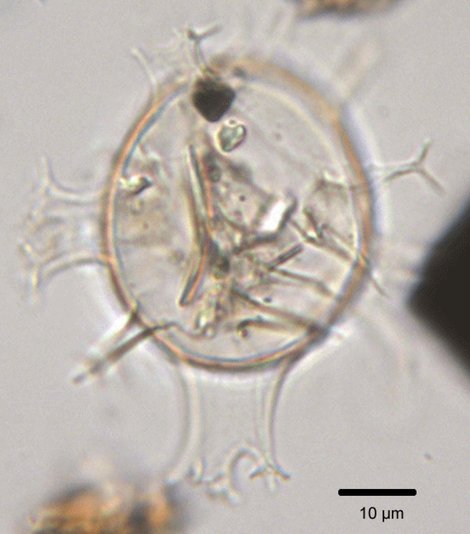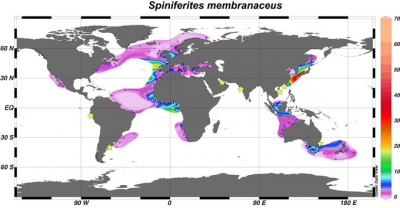Page path:
- Modern Dinocyst Key
- transparent cysts
- Septa and processes
- Cysts with antapical protusions
- Spiniferites membranaceus
Spiniferites membranaceus
Zonneveld, K.A.F. and Pospelova V. (2015). A determination key for modern dinoflagellate cysts. Palynology 39 (3), 387- 407.

cross section
photo: Fabienne Marret
locality: Celtic Sea
source: Marret and Scourse, 2002
photo: Fabienne Marret
locality: Celtic Sea
source: Marret and Scourse, 2002
Field characteristics
Spiniferites membranaceus (Rossignol 1964) Sarjeant 1970
Field characteristics:
Proximochorate ovoid cyst with microgranular to microrugulate wall. Tabulation is expressed by sutural septa. A characteristic suturo-cavate process is present at the plate boundary between the 4’’’ and the 1’’’’ paraplates. Gonal and occationally intergonal processes are trifurcate and with Y-shaped terminations respectively. Archeopyle is precingular (type P).
Dimensions: 34 to 57 (width) x 34 to 50 (length) µm; length of processes: 12 to 17 µm, up to 25; length of the antapical suturo-cavate process: 2 to 21 µm.
Motile affinity: Probably a cyst of Gonyaulax spp. (Lewis et al., 1999).
Stratigraphic range: Lower Miocene to Recent.
Comparison with other species:
The characteristic feature of this species is a higher septa or rather a crown of antapical processes connected by membranaceous sutural septae. Care must be taken with identification of antapical position, since in other species septa between cingular processes may appear higher and could be confused with an antapical septa.
Field characteristics:
Proximochorate ovoid cyst with microgranular to microrugulate wall. Tabulation is expressed by sutural septa. A characteristic suturo-cavate process is present at the plate boundary between the 4’’’ and the 1’’’’ paraplates. Gonal and occationally intergonal processes are trifurcate and with Y-shaped terminations respectively. Archeopyle is precingular (type P).
Dimensions: 34 to 57 (width) x 34 to 50 (length) µm; length of processes: 12 to 17 µm, up to 25; length of the antapical suturo-cavate process: 2 to 21 µm.
Motile affinity: Probably a cyst of Gonyaulax spp. (Lewis et al., 1999).
Stratigraphic range: Lower Miocene to Recent.
Comparison with other species:
The characteristic feature of this species is a higher septa or rather a crown of antapical processes connected by membranaceous sutural septae. Care must be taken with identification of antapical position, since in other species septa between cingular processes may appear higher and could be confused with an antapical septa.
Geographic distribution
Geographic distribution based on :
Zonneveld et al., 2013. Atlas of modern dinoflagellate cyst distribution based on 2405 datapoints. Review of Palaeobotany and Palynology, v. 191, 1-197
Zonneveld et al., 2013. Atlas of modern dinoflagellate cyst distribution based on 2405 datapoints. Review of Palaeobotany and Palynology, v. 191, 1-197
Spiniferites membranaceus has a temperate to equatorial distribution. It occurs in coastal as well open oceanic sites which can be full-marine or experience temporarily or permanently reduced salinities. It can be present in oligotrophic to eutrophic environments and bottom waters are hypoxic to well-ventilated.

Distribution:
Spiniferites membranaceus is observed in temperate to equatorial regions with the sub-tropical fronts forming roughly the margins of its distribution in both hemispheres. It mainly occurs coastal and in the vicinity of the continental margins although it can be found sporadically in the central part of the oceans as well. High abundances (up to 60%) occur in the East China Sea, Sea of Japan, the Iberian upwelling area (eastern North Atlantic), the southern part of the NW African upwelling area and the Congo River plume (eastern equatorial Atlantic Ocean).
Environmental parameter range:
SST: -0.9 - 29.8°C (winter - spring) with summer SST: > 5.6°C. SSS: 17.5 - 39.1 (summer - summer), [P]: 0.06 - 1.06 μmol/l, [N]: 0.1 - 12.0 μmol/l, chlorophyll-a: 0.05 - 20.0 ml/l, bottom water [O2]: 0.05 - 7.3 ml/l. Spiniferites membranaceus is abundant in regions where SSS is seasonally or permanently reduced as a result of river discharge influence.
Comparison with other records:
Apart from the records in the dataset of this Atlas, Spiniferites mebranaceus has been observed in surface sediments of coastal sites of the South China Sea, the Gulf of Oman, off India (eastern Arabian Sea), the Saanich Inlet (BC. Canada), The Bahía Blanco (Argentina) and the upwelling area off Peru (eastern equatorial Pacific, Bradford, 1975; Grill and Guerstein, 1995; Godhe et al., 2000; Biebow et al., 1993; Wang et al., 2004c; Price and Pospelova, 2011). Although it has been observed where SST are< 0°C in winter it is not observed at sites with seasonal ice cover (de Vernal et al., 1998; Radi and de Vernal, 2008). In seasonal distribution and sediment trap studies no clear relationship between S. membranaceus production and seasonal variations in environmental conditions (Montresor et al., 1998; Ribeiro and Amorim, 2008).
Spiniferites membranaceus is observed in temperate to equatorial regions with the sub-tropical fronts forming roughly the margins of its distribution in both hemispheres. It mainly occurs coastal and in the vicinity of the continental margins although it can be found sporadically in the central part of the oceans as well. High abundances (up to 60%) occur in the East China Sea, Sea of Japan, the Iberian upwelling area (eastern North Atlantic), the southern part of the NW African upwelling area and the Congo River plume (eastern equatorial Atlantic Ocean).
Environmental parameter range:
SST: -0.9 - 29.8°C (winter - spring) with summer SST: > 5.6°C. SSS: 17.5 - 39.1 (summer - summer), [P]: 0.06 - 1.06 μmol/l, [N]: 0.1 - 12.0 μmol/l, chlorophyll-a: 0.05 - 20.0 ml/l, bottom water [O2]: 0.05 - 7.3 ml/l. Spiniferites membranaceus is abundant in regions where SSS is seasonally or permanently reduced as a result of river discharge influence.
Comparison with other records:
Apart from the records in the dataset of this Atlas, Spiniferites mebranaceus has been observed in surface sediments of coastal sites of the South China Sea, the Gulf of Oman, off India (eastern Arabian Sea), the Saanich Inlet (BC. Canada), The Bahía Blanco (Argentina) and the upwelling area off Peru (eastern equatorial Pacific, Bradford, 1975; Grill and Guerstein, 1995; Godhe et al., 2000; Biebow et al., 1993; Wang et al., 2004c; Price and Pospelova, 2011). Although it has been observed where SST are< 0°C in winter it is not observed at sites with seasonal ice cover (de Vernal et al., 1998; Radi and de Vernal, 2008). In seasonal distribution and sediment trap studies no clear relationship between S. membranaceus production and seasonal variations in environmental conditions (Montresor et al., 1998; Ribeiro and Amorim, 2008).


